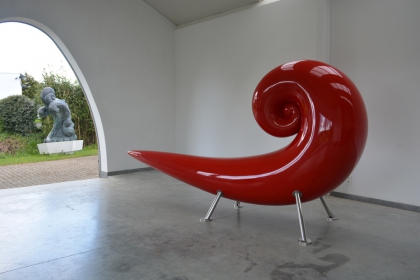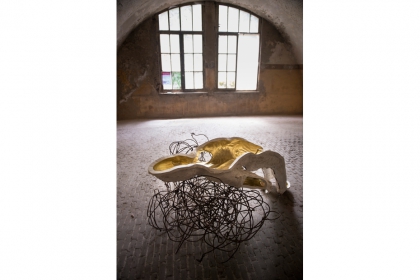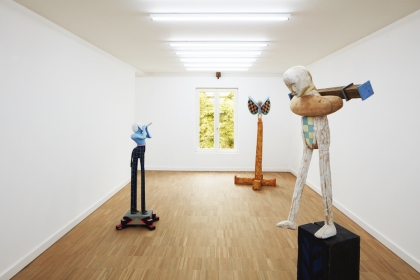Luk Van Soom was born in Weelde-Statie on 27 October 1956. Sixty years later, he has been credited with numerous exhibitions, commissions and projects within Belgium and abroad. Van Soom represented Belgium, for instance, at the Worldexhibition held in Spain (1992) and installed, for Beaufort (2006), a twelve-meter-tall lighter on the beach at Middelkerke. In addition to this he created more than fifty works for the public domain in the Netherlands and Belgium: urban projects such as Walhalla (1993, Antwerp), The Man from Atlantis (2003, Brussels), The Wharfinger (2005, Zwolle) and Walking to Magdalena (2012, Ostend).
In 2015 he was granted an audience with Pope Francis, to whom he presented Oh Superman! (2010), his own version of the crucifix. For his monograph Into view - Tevoorschijn he has been able to count on contributions by art experts such as Lisette Pelsers, Jan Teeuwis, Stef van Bellingen, Sara Weyns and Geerdt Magiels; but also by people from other fields, including Rik Torfs, Frank De Winne and Christine Van Broeckhoven.
With his recent sarcophagus series, he more than ever breathes life into his sculptures, by means of plaster casts and gold paint.
Into View - Tevoorschijn
Nobody could ever reproach Luk Van Soom for failing to come up with surprises. But his new series is astonishing not only due to its visual language. The plaster mold, always with a support construction since it would fall apart otherwise, is an age-old technique in sculpture. According to the rules of this art, he produces half of a mold, which is held up by a crude framework of wooden slats. The hollow interior is painted gold by him. And abracadabra, the negative image appears before our eyes as a positive one. A golden spirit from the hereafter.
While I was gone, says the apparition laconically. Or did it show up while the artist was away for a moment? Clearly a work by Van Soom, with those characteristic traces of his hand movements. Apart from that it’s different from anything else. On the one hand the plaster figure is caught in the wooden slats, and on the other a man in his birthday suit is heading toward us. A bit like those famous Slaves of Michelangelo trying to work their way out of the marble. Those sculptures are known for being the earliest examples of ‘Non-Finito’, the deliberately unfinished sculpture as the final product.
Dormire su una Nuvola is a figure that lies dozing on a cloud of metal wires. The plaster shell is reminiscent of a sarcophagus or a mummy case in the shape of a person, but more than ever Luk Van Soom breathes life into his sculptures. Thanks to the gold paint. He himself had to think of Tutankhamen’s tomb, which he visited. In Egypt gold stands for the divine and for eternal life. Now the gold paint deceives our brain, so that we perceive the hollow form as a filled-out figure. An intangible manifestation.
The portrait of the late Frank Zappa pokes fun, to some degree, at Tutankhamen’s gold death mask. In his studio the artist often listens to Zappa’s music, which has a certain intangible quality. And look: the pop genius is peering over his shoulder, as it were, from the great beyond. The mold as a gateway to another world, as a link between the material and the immaterial.
As a child Van Soom was fascinated by stories about apparitions and ascensions to heaven. Noli me tangere, touch me not, Christ said when he appeared to Mary Magdalene. The Assumption of Mary Magdalene is her ascension. Seen from the side, a somewhat tormented figure, trapped inside the wooden support construction that leans against the wall. But from the front, we get a sense of something supernatural going on. It’s a high point in his pursuit of weightlessness, which was prompted by Andrea Pozzo’s baroque ceiling fresco in the Sant’ Ignazio church in Rome: whirling figures being sucked up to heaven. Lots of suspension power all of a sudden. And to think that he achieved this with half a mold in a support frame, actually in a studio situation.
In art history we find no direct examples of the traditional plaster mold, which becomes an artwork on its own. We do find all sorts of molds, however, and the idea of the mold. Starting with Marcel Duchamp. His plaster mold of a woman’s bottom, a concave physical imprint from 1950-51, looks like a cast when it appears on the cover of the magazine Le Surréalisme, même. Via photography the brain can be equally misled, so that we interpret a concave form as a convex form. Generally speaking, this relates most of all to the golden figures. Then you have Marcel Broodthaers and his conceptual dealings with ‘la moule’, a French word that means both ‘mussel’ and ‘mold’. And a whole range of negative forms.
But the mold as an autonomous work of art? Ultimately this series might bring to mind George Segal, who duplicated bodies with the technique of the plaster cast. Or Antony Gormley, both his sculptures that refer to Egyptian mummy cases and his energetic figures made of steel rods. In the work of Didier Vermeiren, an investigation into the identity of sculpture, you do find plaster pedestals, on which the plaster mold of each pedestal stands. The fundamental principles of sculpture and the process are, for the first time, also at work in the sculptures of Luk Van Soom. But to an even greater extent, it’s the miracle of art being manifest.
Christine Vuegen





